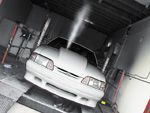
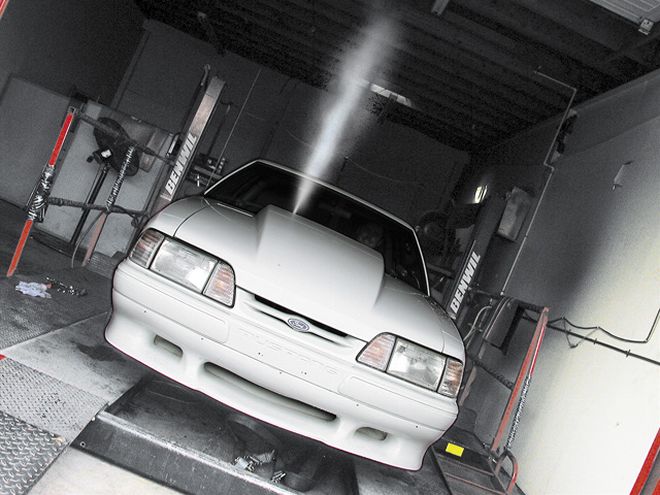
Cheap and fast aren't usually synonymous, and plans for big-horsepower street machines are often confined to our daydreams. But there are exceptions, and one of them is called nitrous oxide.
Due to the low entry-level costs and relatively easy installation, nitrous kits are more popular than ever, and they offer the advantage of horsepower on demand without compromising the streetability of a car that may be your daily driver. With that said, nitrous kits for fuel-injected cars like our 5.0L '89 Mustang GT are generally more complicated and expensive than typical plate systems that fit under a carburetor, so we were eager to try out this innovative new EFI system from Nitrous Express when we saw it at last year's SEMA show. While most nitrous systems for fuel-injected cars have been somewhat limited, NitrousExpress has a new line of NXL systems that essentially act as direct-port injectors, making the system far more capable than a traditional plate system that sandwiches between the two halves of the 5.0L's intake manifold.
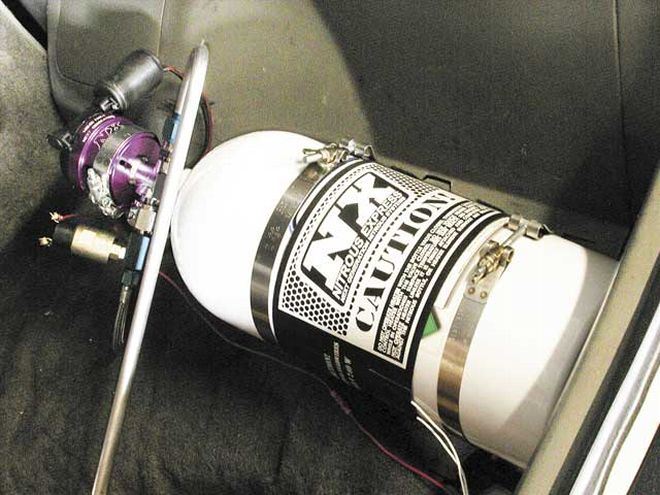 Nothing to see here, move along.
Nothing to see here, move along.
The NXL system employs a series of nozzles that fit between each fuel injector and the manifold to deliver nitrous and fuel directly into the combustion chambers like direct-port injection. Additional enrichment fuel is supplied by a separate line that connects to the factory fuel system along with the nitrous line routed from a billet aluminum distribution block. From there, two fuel and two nitrous Teflon lines are attached to each NXL nozzle. Don't worry about the integrity of the Teflon lines--they're rated at over 27,500 psi burst pressure and feature an insulated woven mesh, a Teflon inner lining, and a vinyl outer coat. While the NXL system may look complicated, the nozzles promote a much more efficient atomization process by spraying in a cross pattern directly into the cylinder. We also like the idea of having an independent fuel source for our power adder instead of a dry system that relies on the fuel injectors for additional fuel.
Although we're showcasing this new NXL system on a 5.0L powerplant, you'll be happy to know that this trick new technology is also available for GM LT1 and LS1 engines and Ford's Modular 4.6L engines. The same nozzles used in our kit will drop into all of the previously listed applications with only minimal changes in the length of the Teflon lines. Read on to find out the incredible dyno results.
Fuel-System Upgrades
We can't even begin to tell you the number of times we've heard, "Nitrous is cheating," or, "You'll blow up your motor with noss." The fact is that adding power may require additional upgrades regardless of the method. When problems arise, it's usually the result of ignoring manufacturer recommendations or using substandard components that weren't up to the task of handling the additional power in the first place.
Knowing that we had every intention of going fairly big with our daily commuter, we removed the original 130,000-mile fuel-system components and upgraded the fuel system with a Mallory fuel pump and fuel regulator, ACCEL 24-lb/hr injectors, and a larger 80mm mass-air meter from Granatelli Motor Sports (GMS) calibrated to match the injectors. If you find yourself debating between factory replacements or performance upgrades for maintenance components, keep in mind that many of the upgrades we've selected don't cost substantially more, will ultimately provide better peak performance, and can offer better peace of mind.
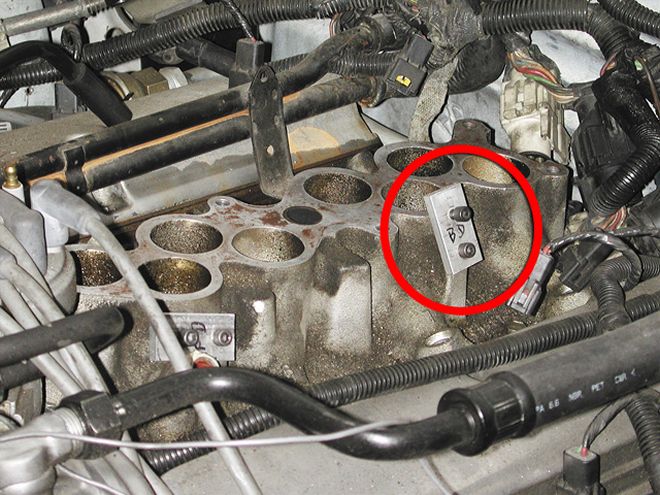 Installing the NXL system is easy, straightforward, and requires very little time. Route the nitrous feed line from the rear of the car, and then start by removing the upper manifold, fuel rails, and injectors. Since the NXL nozzles need to be placed into the manifold injector bosses, you'll find that the fuel injectors will rest slightly higher. To correctly seat the fuel rail onto its new position, start by securing the lower bolts of the relocation bracket (red circle) to the manifold.
Installing the NXL system is easy, straightforward, and requires very little time. Route the nitrous feed line from the rear of the car, and then start by removing the upper manifold, fuel rails, and injectors. Since the NXL nozzles need to be placed into the manifold injector bosses, you'll find that the fuel injectors will rest slightly higher. To correctly seat the fuel rail onto its new position, start by securing the lower bolts of the relocation bracket (red circle) to the manifold.
Engine Specs
Heads: Factory cast iron E7TE, 1.72/1.46-inch intake/exhaust valves
Cam: Crane Cams hydraulic roller, 220/220 degrees duration at 0.050-inch lift, 0.498/0.498-inch lift
Induction: GMS 80mm mass air meter, Accufab 65mm throttle body, Ford Cobra upper and lower, ACCEL 24-pound injectors
Piston: Stock forged aluminum
Rods: Stock
Crank: Stock
Exhaust: 15⁄8-inch shorty FRPP headers, 21⁄2-inch cat-pipe and tubing
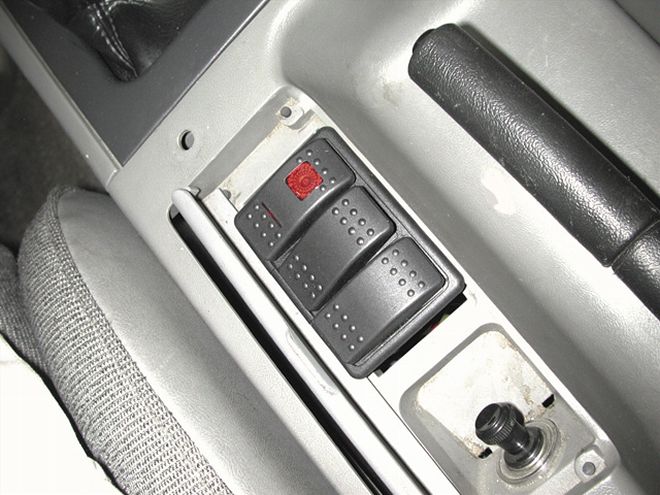 The three-button control panel features five separate functions. Pressing button A to the left activates the bottle heater, while pressing the button to the right arms the system. Button B is the momentary switch for the purge. Button C opens the bottle when pressed to the left and closes the bottle when pressed to the right. It's ergonomically friendly, extremely functional, and we especially like its inconspicuous design.
The three-button control panel features five separate functions. Pressing button A to the left activates the bottle heater, while pressing the button to the right arms the system. Button B is the momentary switch for the purge. Button C opens the bottle when pressed to the left and closes the bottle when pressed to the right. It's ergonomically friendly, extremely functional, and we especially like its inconspicuous design.
Hot Tips for Peak Nitrous Performance
- Always read the manufacturer's instructions
- Make sure you have an adequate fuel system
- Use a bottle heater to maintain proper bottle pressure between 900 and 1,050 psi
- Install non-platinum spark plugs one to two heat ranges colder than stock. Platinum plugs create a smaller flame and the spark can easily get blown out.
- Only engage the nitrous system at wide-open throttle
- Never engage the nitrous system below 2,000 rpm
- Prevent contaminants from entering the nitrous and fuel lines during jet changes by having clean hands and a clean work area
- Only use premium fuel with a fuel additive like NX's Chemical X (PN 16003)
- Use quality plug wires and an aftermarket ignition with 150-plus-horsepower nitrous shots
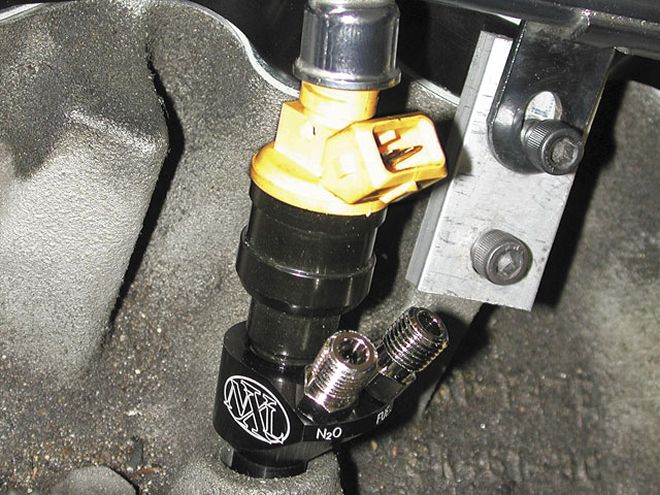
NXL Technology
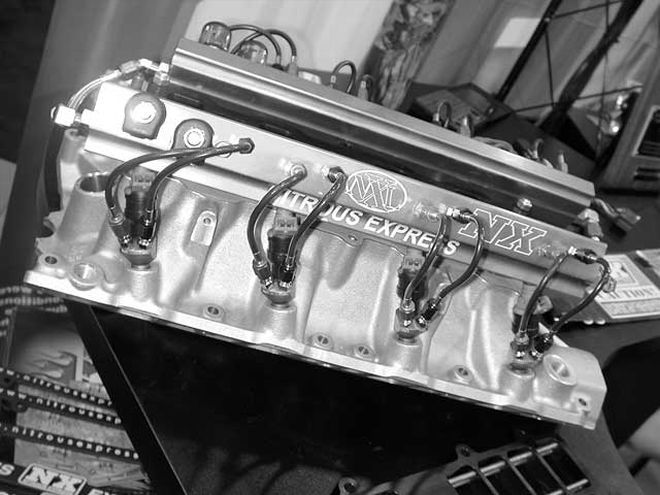 For an even easier installation, NX offers replacement fuel rails for some applications that come with the nitrous and fuel solenoids already integrated into new billet rails.
For an even easier installation, NX offers replacement fuel rails for some applications that come with the nitrous and fuel solenoids already integrated into new billet rails.
The Nitrous Express billet aluminum NXL nozzles may be intended for the average weekend enthusiast who's looking for some extra grunt, but don't let their simplicity mislead you. The direct-port system can pack an additional 400 shot of tire-shredding powder should the need or temptation ever arise. Granted, most of our average street motors wouldn't survive very long under those extreme conditions, but it shows that this system was designed with power in mind and is suitable for hard-core race applications.
We were told the NXL system can also be configured into a two-stage setup by stacking two sets of nozzles together. This requires additional lines, solenoids, and a taller cowl hood for clearance. So, if you think a 400 hit isn't enough, Nitrous Express has already got you covered.
How well did she do?
Peak Dyno Numbers HP (ft. lbs) Gain Baseline, no nitrous 213.0 264.0 n/a 80-shot 308.9 427.7 +95.9/+163.7 100-shot 321.9 459.0 +13.0/+31.3 150-shot 366.8 505.8 +44.9/+46.8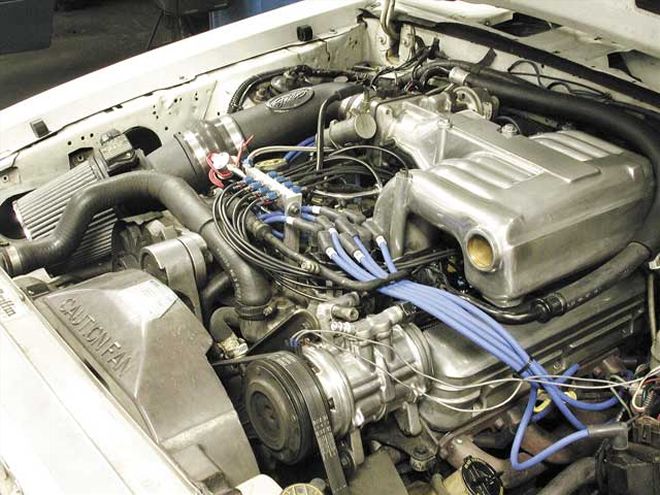
To add the finishing touches, we swapped out the Autolite 25 spark plugs with a set of 23s (two heat ranges colder) and gapped them at 0.035 inch since we planned on spraying the little 306ci with a healthy 150-shot of nitrous. If you plan on sticking with the lower nitrous setting, your stock plugs will be fine. Also be aware that heavy nitrous hits have the potential to "blow out" the spark, so it's crucial to use quality performance wires like these JBA Headers 9mm power cables and an aftermarket ignition box. The finished product looks intimidating, but if a local grudge-night yahoo asks you about it, just tell him it's part of the emissions equipment